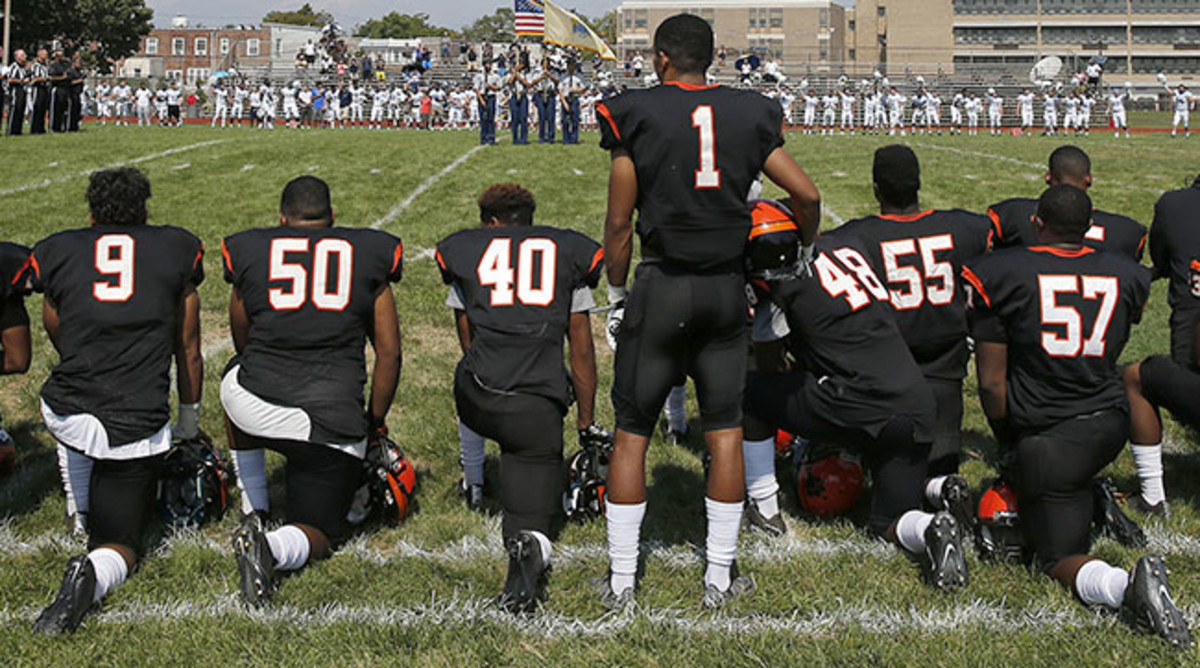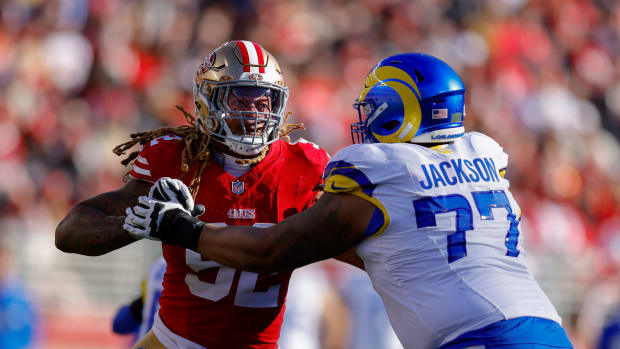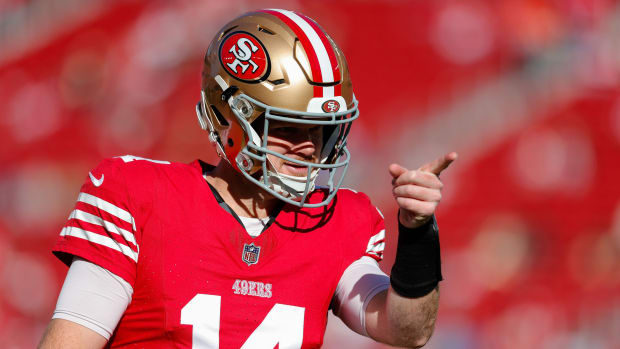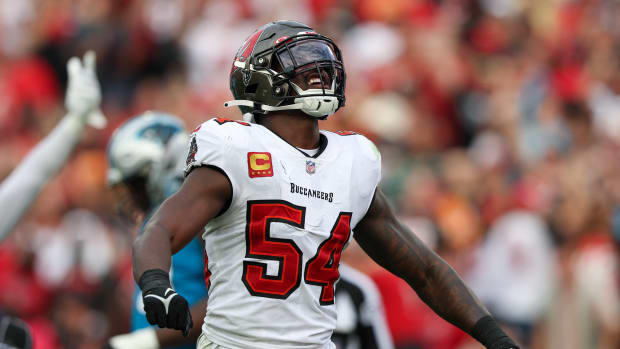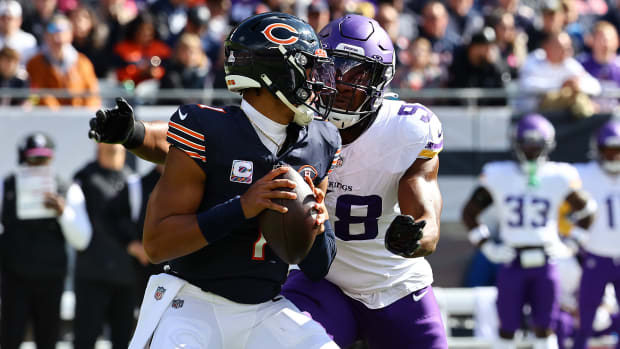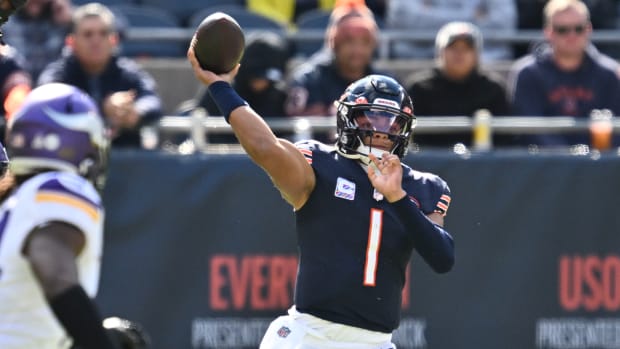High School Football, Kaepernick and the Anthem
What’s the price for a black man life?
I check the toe tag, not one zero in sight
I turn the TV on, not one hero in sight
Unless he dribble or he fiddle with mics
CAMDEN, N.J. — Preston Brown sings along as J. Cole’s “January 28th” blares from his car speakers. It’s Saturday morning, three-and-a-half hours before kickoff, and Brown, the head football coach at Camden’s Woodrow Wilson High School, is on his way to pick up team breakfast at a local diner. The streets and sidewalks are empty save for a few of his players, dressed in bright orange and black sweats, making their way to the field. Brown nods and taps his horn as he passes each one.
The lyrics echo his own message, the song a sort of personal anthem. Brown is 31 years old, black, and a Camden native. Following Colin Kaepernick’s lead, Brown encouraged his players to kneel for the national anthem before games this season. The majority of his 65 players, all black or Latino, have done so.
“When Kaepernick kneeled, I felt like he was doing it for people who live in our situations, like Camden,” Brown says.
It’s been a little over two months since the nation first noticed Kaepernick sitting down for the national anthem before a 49ers preseason game. In the following weeks, the movement has spread across the country and across several sports. According to a ThinkProgress report, players and coaches from at least 52 high schools, 39 colleges, one middle school, and two youth leagues in 35 states and three countries abroad have participated in some form of anthem protest.
“He led us in a way, without us even knowing,” senior wide receiver Genaro Medina, who is Puerto Rican, says of Kaepernick. “It really brought a lot of us together on what is going on around our area, which a lot of people don’t understand.”
* * *
Camden is notorious as one of the most dangerous cities in America. Its violent crime rate, 20.32 per 1,000 people, is well above the national average of 3.8. Forty percent of the 77,000 residents are living below the poverty line.
At Wilson, the 2015 graduation rate was just 63 percent, well below the state average (but an improvement from a 46 percent rate in 2012). There is a glaring lack of resources, evident when looking at the football program. The Tigers play all their home games on Saturdays at noon because Mike Rozier Stadium doesn’t have lights. The football “office” is part locker room, part storage room, part cafeteria. An Apple desktop computer sits on a dusty table, alone on an island above a jumbled mess of broken chairs, ripped boxes, and other debris. After getting breakfast, Brown will head to Home Depot to pick up a generator to power a rare perk: a DJ for that day’s homecoming festivities.
“Why don’t we have lights?” assistant head coach Brandon Bather asks. “When we practice during the week, we have to be off the field before it’s dark and daylight savings is coming. Other teams can practice longer, but we’re set up to lose.”
The day before Wilson’s first game, Brown gathered his players and coaches to explain to them why he would be kneeling for the anthem. “I want direct changes for people in communities like Camden, for people like us to have the same joys and freedoms that our national anthem expresses,” he told them.
When Brown was 11 years old, his Haitian grandmother taught him about a line in the third verse of the of the Star-Spangled Banner (traditionally at sporting events only the first verse is performed) that references the death of black slaves who were recruited to fight for the British on the promise of gaining their freedom during the War of 1812.
No refuge could save the hireling and slave
From the terror of flight, or the gloom of the grave
“The anthem wasn’t originally created to include black people,” Brown says. “Ever since she told me that in sixth grade I stopped standing for the pledge of allegiance, I really stopped standing for the national anthem. I would get detention all the time. I would always ask my teachers why—if I have a choice to do as a please—why do I have to stand? I always questioned that.”
After graduating from Wilson in 2003, Brown went on to play receiver at Tulane, where he was a team captain for two years. He usually occupied himself with talking to the trainer or drinking water during the anthem, never standing at full attention. “All my life in sports I felt like it was just done as a formality,” Brown said. “All rise, everybody has to stand. It was just never a song that moved me because, I wonder, why do they keep the third verse out?”
Brown returned to Wilson in 2015. Along with coaching football, he is the dean of culture and climate, an administrative role created for him that is part counselor, part security guard.
He wanted to make sure his players didn’t feel any pressure to kneel, but also wanted them to understand the societal issues and racial inequality in their community.
“Some of the economic disparity we see, even in Camden, neighboring towns that are literally across the street from us, the housing values are so different. One side of the street the highest priced house may be $40,000. Directly across the street the lowest house may be upwards of $100,000. People buy houses where school districts are thriving. Our school district has been considered failing for the last 40 years!”
Wilson players had seen Kaepernick’s protest and had already been discussing it when Brown brought it up. “I always felt like us, coming from where we come from, we had to do something, we had to respectfully show people what we go through and how we feel,” said senior left guard Daniel Medina (no relation to Genaro Medina). “Like coach said, everybody is taking a knee for one another because we are hurting.”
The next day at noon, Brown took his place for the anthem facing the field with his back to the team. He didn’t know if any of his players would kneel with him. When he rose to his feet at the anthem’s close, he turned to see that all but two had.
“Kneeling, to me, has never been a sign of disrespect,” Brown says, as he turns his car into the parking lot behind the high school, trays of buttery toast, home fries and scrambled eggs now piled in the backseat of his Ford Escape. “When there is injury in sport, we kneel as a sign of respect, because when someone is injured they are hurting. And when that person walks off, we clap as a sign that things are getting better. Well, we are hurting, based off of who we are, and what happens to us in this country, so we can’t begin clapping because we haven’t seen that side of it yet.”
* * *
MINNEAPOLIS NORTH HIGH SCHOOL, MINNEAPOLIS
“As soon as I saw [Kaepernick] do it, I knew that younger generations would follow,” says Charles Adams, head coach at Minneapolis North.
Sure enough, his players approached him about kneeling before their first game, but Adams was concerned they were just following along without understanding what the protest stood for.
“I told them, you guys better sure as hell know what you are taking a knee for and be able to explain that to people when they ask you,” Adams says. “A lot of them had no clue why. They couldn’t even explain to me the reasoning. Even a couple players said it was an opportunity to do it because everybody else was doing it.”
Adams brings a unique perspective. He is a black coach of an all-black team. He is also one of three police officers on North’s coaching staff. He has tried to educate his players on the perspective of a law enforcement officer. Adams, who players call “O.A.” (Officer Adams) for short, said that the coaches and players have had many conversations about the killing of black men by police. In particular, the team discussed the fatal police shooting of Philando Castile in July, which occurred in Falcon Heights, a nearby suburb of St. Paul.
“They were pretty upset about it,” Adams says. “We talked about how to conduct yourself on a traffic stop. They still get frustrated with the way things happen, with all the shootings and killings, and a lot of it makes sense why they feel the way they do. But we also tell them our take, as officers, on why things get to where they get to.”
Adams is torn about the anthem protest. He chooses to stand, while a handful of his players kneel. “It is a tough position to be in,” Adams says. “None of my kids have ever questioned me why or why not. I just try to give them information and they know that I don’t do my job the way that others perceive it. They don’t look at us the way they [look at] other [police].”
* * *
WATKINS MILL HIGH SCHOOL, GAITHERSBURG, MD.
“If my kids and the Camden kids and Kaepernick piss millions of people off, but it makes one police officer not shoot and it saves a life, then it is totally worth it,” Watkins Mill head coach Mike Brown says.
Brown, who is biracial (his mother is white and his father, now deceased, was black), chooses to stand for the anthem, but says that 98 percent of his team kneels. “I support them 100 percent,” he says. “But I also think there are probably better ways that you can show your displeasure with the way minorities are treated.”
Black and Latino students make up 75% of Watkins Mill’s student population, according to Montgomery Public Schools data. During a game at Damascus, a Montgomery public school with a predominantly white student population, Brown says the Damascus fans directed hateful comments toward his players.
“There are some very ignorant people out there,” Brown says. “We tell our kids everyday to stand up for what they believe in, and then they do it, and you give them a hard time. I am extremely, extremely proud of these boys and how brave they’ve been through it all. When I was 16, in high school, I never could have done this.”
* * *
WOODROW WILSON HIGH SCHOOL, CAMDEN, N.J.
The opening notes to the Star-Spangled Banner play over the loudspeakers at Mike Rozier Stadium. Preston Brown lowers his hulking 6'4" frame down toward the grass. All but three of his players kneel behind him. Several raise their fists in the air. Across the field, Delsea High School players in red and white jerseys stand and hold hands down the line.
After the Tigers’ first game, the hate mail came pouring in via emails, phone calls, tweets, Facebook messages and letters.
Get the F--- out of this country if you don’t like it!
You’re anti-American
Take your political views and shove it up your a--
“Somebody said they hate me more than anything in the world for doing what I did,” Brown says. “When somebody said something negative, I would just reply, If you’d like to have an intellectual conversation that is not calling each other names, if you truly believe that what I am doing is causing a divide, let’s work together and bridge this gap. And nobody ever responded to that.”
“There was a lot of negativity in the beginning from people all over, I had never seen nothing like that before,” Genaro Medina says. “I’d go on Twitter and see, like, a thousand tweets calling us a prison school.”
“They were calling us n------, saying that we aren’t educated,” adds senior linebacker Anthony Ramos.
Senior running back George Milton III is one of the Tiger players taking a knee. His father, George Milton Jr., is one of several fans who remain seated while the anthem plays. When asked if his sitting was purposeful, Milton says, “Yes, I’m part of this. I grew up in the city of Camden and it hasn’t been easy, but I am still here. I am still here. I’ve dealt with some of those injustices, being pulled over because of my color, being profiled.
“My son and I always have talks about the different injustices and things that you have to deal with as a young black man in America. It is nothing new for me.”
Most players on the team have their own stories of discrimination. Genaro Medina, 17, was stopped by an officer while riding his bike home from practice earlier this season. “He asked me, ‘What is in your book bag?’” Medina says. “Cops around here, they see us and right away they think we are trying to start a problem. They see us on a corner, and they want to clear it instantly. They don’t want to see us with our shirt off or anything like that, they think there is an issue going on.”
“Cops harass us,” Daniel Medina says. “I could just be walking down the street and it might be cold out and I could have my hoodie on and they think I am up to no good.”
This past summer, Brown took 15 players to Charleston, S.C. for a visit to The Citadel, a school that has offered scholarships to a few Wilson players in the past. While there, the group decided to go to the beach. “In the six blocks that it took us to walk to the beach, we were stopped and questioned three times by three separate policing units,” Brown said. “My four-year-old son asked me, ‘Why do we keep getting stopped by cops?’ It’s just those types of hurts. We are supposed to live in a land that is so free, but we can’t even walk to the beach without being stopped by police.”
To help improve the relationship between the community and the police, the team has partnered with NYU law students to work on a policing project to get new laws and ordinances passed, and to help support the idea of youth and police working together.
Every protest has a beginning and an end. This one will likely end with the Tigers season. “Next year we will probably go back [to standing],” Bather says. “But hopefully, in that time period, things will change. A lot changes in a year. Last year, we weren’t talking about this. This year we are.”
Question or comment? Email us at talkback@themmqb.com.
































